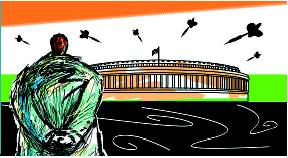Anti-Congressism is the common plank of those motivated by short-term political gain.
Peeling the onion of political ideology inIndia Waterloo
Peeling the onion of political ideology in
There are also 1960s-style anarchic groups that include the Anna Hazare autocratic clique and Mamata Banerjee’s socially and intellectually challenged Trinamool Congress. Plunk into the mix the personality cults of Mayawati; the dynastic set-up of Mulayam Singh Yadav, Karunanidhi and Naveen Patnaik; the slippery appeal of Jayalalithaa and the holier-than-thou stance of Nitish Kumar. These are mercenary formations that will sway whichever way the wind blows, depending on the political advantage they can derive.
It is not clear what any of these groups stand for except opposition to the Congress. In 1974, the great anarch Jayaprakash Narayan talked of “total revolution” and called on the army to revolt against the Indira Gandhi government; today Anna has subverted his fight against corruption into an anti-Congress political movement. Talk about deja vu.
The foolishness of the Anna band of civil society buccaneers was exposed when the moving spirit, Arvind Kejriwal, was forced to issue a statement that they are not anti-Congress. Earlier, when cornered by thinking people on a television show, he said that India
Meanwhile, BJP leader L K Advani led a rath yatra against money in Swiss banks in a nonetoo-subtle bid to cash in on Anna’s storm in a teacup against corruption. Of classic RSS vintage, he believes no one remembers his other 1990 Ram temple effort which led to communal riots. So where is the “glorious” temple he promised? He served as home minister and deputy prime minister for the six years the BJP-led coalition was in power. Advani’s confusion was complete when he went to Karachi
There are many ideological fig leafs that political formations wear in their relentless grasp for power: socialism, casteism, social justice, identity, chauvinism, Hinduism. Scratch the surface and it all turns out to be an anti-Congress position. As such, political analysis in India
So let’s look at the Congress record. It has been the default option for the electorate. In the past quarter century, it suffered seminal defeats in the elections of 1989 and 1996. In each case, it was voted out of power on allegations of corruption. Each time, a coalition of parties was hastily put together that stood for nothing except opposition to the Congress. In both those defeats, any objective analyst could conclude the Congress lost because its governments undertook significant reforms that hurt the status quo.
In 1989, an agglomeration of forces came together to restore the status quo of inequity and discrimination that Rajiv Gandhi had challenged. The motley crew of political parties that formed the opposition put together a makeshift government that did not last the full term; nor did they pursue the charges of corruption that brought them to power.
In the ensuing decade, the BJP’s unbridled appeal to communalism brought it to power: first, for 13 days in 1996; then in two desperate coalitions in 1998 and 1999. The saffron dispensation lasted until 2004 and was then showed the door because of its misplaced nationalism that saw India conduct nuclear tests that were replayed tit-for-tat by Pakistan
Since then, the Congress has held sway. The key difference is the Congress’s approach to social harmony and economic development: the phrase “inclusive development” was introduced to the political vocabulary. In the interim, India
Unmindful of these achievements, the anti-Congress brigade has spread several falsehoods: the prime minister is opposed by Congress president Sonia Gandhi ; Manmohan Singh is weak; Sonia is the real power.
The truth is different: both Singh and Sonia are on the same page as they have always been. There has been in the history of the Congress no better combination. The former pushes reform in foreign and economic policy; the latter is the conscience to ensure there is a local sensitivity to these reforms. That is the operational definition of “inclusive growth”.
It’s ironic that the anti-Congress formations should denigrate both leaders. Singh is a highly respected economist who forsook academic achievement to serve the country first as a bureaucrat, then as finance minister and prime minister. Sonia, who adopted this country as her home, foreswore the office of prime minister in 2004 and became the conscience of the government.
The writer is a public affairs commentator.
Left and Right against the Centre
This article appeared in The Times of India on January 10, 2012.
This article appeared in The Times of India on January 10, 2012.
Link:
http://epaper.timesofindia.com/Default/Scripting/ArticleWin.asp?From=Archive&Source=Page&Skin=TOINEW&BaseHref=CAP/2012/01/10&PageLabel=14&EntityId=Ar01400&ViewMode=HTML


